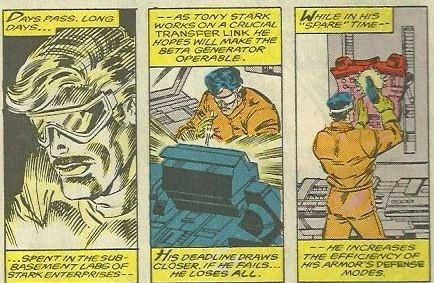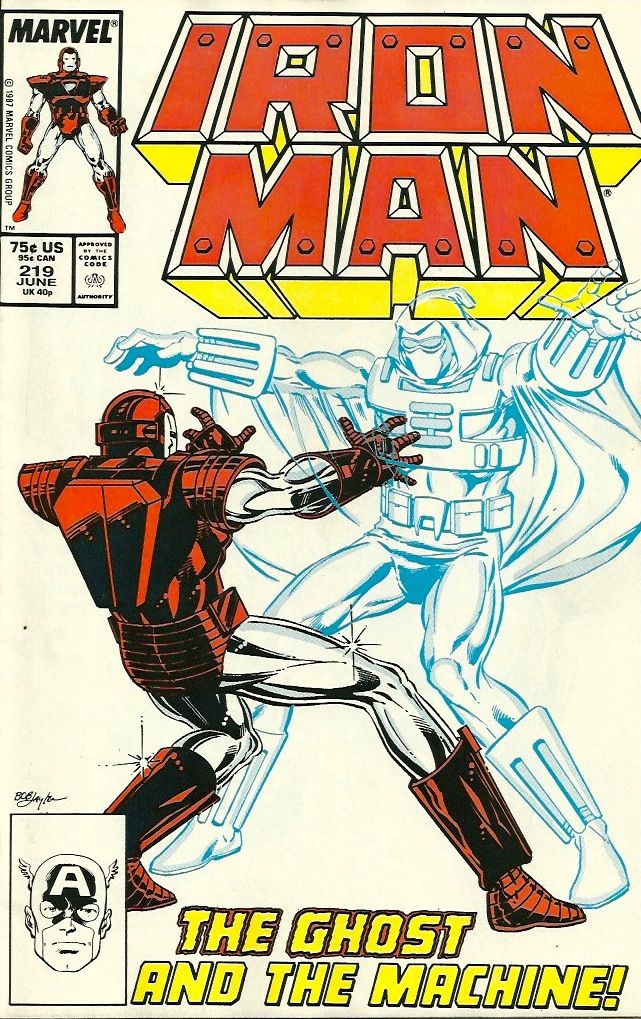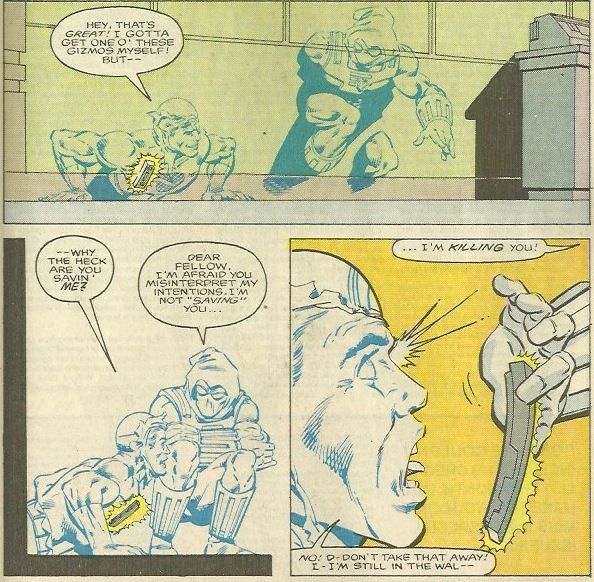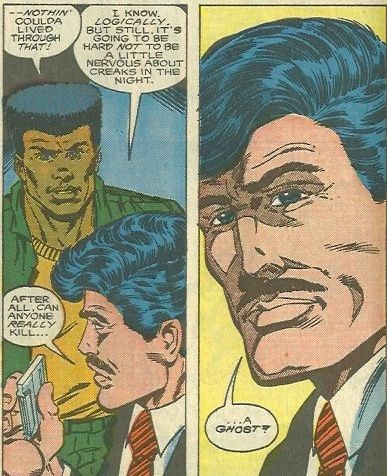A column in which Matt Derman (Comics Matter) reads & reviews comics from 1987, because that’s the year he was born. Click here for an archive of all the previous posts in the series.
Iron Man #219-221 (Marvel) by David Michelinie, Bob Layton, Mark D. Bright (#220-221), Bob Sharen, Janice Chiang, Mark Gruenwald
A good villain should do two things: 1. Work as a compelling character in their own right, someone the audience is interested in regardless of circumstance, and 2. Jive with the hero within the specific context of their shared story. Judged by these two metrics, Iron Man #219-221 is a tremendous triumph, introducing readers to the Ghost, a supervillain whose concept is simultaneously so strong and so simple that he works as a character despite (or because of) a total lack of background details or origin story. We don't need to know exactly where he comes from to understand his motivations and the danger he represents, and he's a perfect foe for Iron Man because of both his power set and his ultimate goals. It's always nice to come to the end of a story and feel fully gratified by it while still somehow wanting more, and that's exactly what this Iron Man arc delivers. There are no glaring loose ends when the narrative concludes, but there are plenty of open doors and unanswered questions, so that it feels complete but also like it's the start of something bigger (which, of course, it is, insofar as the Ghost has made numerous appearances throughout the Marvel Universe in the decades since this initial storyline was published).
The Ghost's name pretty much tells you everything you need to know about his abilities; he can turn invisible and intangible, though he can't be both at once. These are not powers he possess naturally but are built-in features of his costume, a high-tech suit he designed himself to use in his fight against the corporations and other capitalist institutions he so despises. He's an anti-corporate activist/terrorist, and when we meet him, he's in the midst of trying to bring down Accutech, an up-and-coming technology company that Tony Stark is at the same time in the process of acquiring. So of course, when the Ghost is discovered within Accutech's property, Stark is on hand, and quickly dons his Iron Man armor to battle this new enemy. In that first confrontation, there is no clear winner---Iron man prevents Ghost from doing whatever he was there to do, but Ghost still escapes, and leaves behind a threatening message, promising revenge. This begins a struggle between Ghost and Stark that takes weeks to resolve, and costs more than one person their lives along the way.
Part of why the Ghost is such a good opponent for Iron Man in particular is that they are both non-powered human beings with technology-based powers, inventors with the know-how to build their own costumes and, most importantly, to enhance them over time. This means that both men can adapt to one another after each encounter they have, fine-tuning their outfits to make themselves all the more formidable. The first time they fight, Iron Man uses sonics to locate Ghost, so Ghost subsequently adjusts his costume so he can no longer be detected or tracked that way. Similarly, Stark touches up the defenses of his armor and of the entire office building which houses Stark Enterprises, adding heat and motion sensors so that if the Ghost shows up anywhere, there will be a warning. It doesn't really work out for Stark as he'd hoped, but it's a good effort nonetheless, and the real point is that it serves to draw a parallel between the two characters, highlighting the biggest attribute that they have in common. And in the end, it is this kind of technological one-upmanship which defeats the Ghost for good, when Stark builds a defensive field around the piece of equipment that Ghost most wants to destroy, designed specifically to attack nearby electrical systems and therefore the perfect defense against Ghost, whose whole body is essentially covered in an electrical system. That plan doesn't play out quite the way Stark anticipated, either (see below) but it does technically succeed in protecting what Ghost hopes to ruin and definitively thwarting his plans.
Which brings me to the other thing that makes Ghost so perfectly suited to be an Iron Man villain: his fanatical anti-corporation agenda. He is hell-bent on dismantling and devastating any and all corporations, seeing their capitalistic greed as a force of great evil. Stark, on the other hand, is a born-and-bred businessman, as devoted to building a strong, solid company out of Stark Enterprises as he is to any of his Iron Man superheroics. So while their skill sets are similar, their philosophies are diametric opposites, meaning both men have a passionate personal investment in the outcome of their conflict. For Ghost, Stark and his company are a shining example of everything wrong with the world. For Stark, the Ghost poses a potential threat to his livelihood and his future financial stability. Stark puts all of his money into buying Accutech, only to immediately learn that Ghost plans to tear that company apart, so if Ghost were to succeed, Stark would end up penniless, truly unable to move forward with any of his plans and forced to give up everything he'd built up to that point. So for Stark, the pressure of defeating Ghost isn't merely the normal anxiety of a superhero trying to stop a supervillain's schemes. It is quite literally a fight for Stark's life, or at least his way of life, which makes him work that much harder but also takes a significant mental and emotional toll on him. Stark is so afraid of what Ghost could do to him, and so unsure of how to protect himself against an enemy he can't see or touch, that he begins to crack a bit under the weight of it all, sleeping in his armor and spending days on end in his lab to try and figure out a solution. Seeing the book's hero so tormented and at such a loss is gripping fiction, and when Stark's final victory comes from of his own ingenuity rather than by simply besting Ghost in a fight, it is all the more satisfying because of how rattled Stark was earlier in the arc.
Ghost is a pretty terrifying figure on his own, even if you separate him from Iron Man, because of the combination of how little we know about him and how severe his methods are. We don't know how Ghost came to be who and what he is today, but we do discover little by little the depths of his devotion to his cause and the corresponding madness it engenders within him. Initially, he is hired by Roxxon to take down Accutech, but after Iron Man gets involved, Roxxon decides to terminate Ghost's contract. In response to this, Ghost flies right off the handle, screaming at his Roxxon contact that he would gladly do his work for free, and that Roxxon has no power to stop him now that he's begun. That tirade is the first real glimpse we get into Ghost's rocky psyche, and he reveals himself to be even more ruthless and unhinged as the story advances. The most shocking, effective instance of this is when he kills Spymaster, who's hired by Roxxon to put Ghost down when he refuses to play by their rules. After a long fight between Spymatser, Ghost and Stark that spreads throughout Stark Enterprises, Ghost seemingly offers to help Spymaster by giving him a portable version of the tech that allows Ghost to become intangible. The two villains pass through a wall together, as if to make their escape, but when Spymaster's body is only halfway through, Ghost quickly removes the intangibility technology, causing Spymaster's body to resolidify inside the wall, killing him instantly and brutally. It happens so fast and it is such a cruel, merciless move on Ghost's part, it takes a moment for it to really register, or at least it did for me. Spymaster is alive and kicking one minute and stone dead the next, an entire wall separating his torso from his legs. It's the moment where it truly clicks how devoted Ghost is to his mission, and how willing, nay, eager he is to eliminate anyone who tries to get in the way.
As if that wasn't enough to impress upon the reader just how intense Ghost really is, at the end of the story, when confronted with the field Stark built to protect his property, and after Stark explains in no uncertain terms that said field will almost certainly prove fatal to anyone who is exposed to it for too long, Ghost decides, without a moment's hesitation, to go for it anyway. He trudges steadily toward his target in spite of the incessant electrical bombardment, and stays at it for so long that it overloads and overheats his costume to the point where he literally melts through the floor. A character who is willing to sacrifice themselves for what they believe in is nothing new, but it is the confidence with which Ghost makes that decision that is so damn unsettling. It's tough to watch someone choose to end their own life, no matter how villainous they've been prior to that point, and Ghost never pauses or doubts himself for a second. On the contrary, after being blasted once, he pulls himself up immediately for another go, knowing full well it will likely be the last thing he ever does. And it is, at least as far as this story is concerned, though writer David Michelinie does go out of his way to say that the Ghost may not really be dead, just temporarily defeated. The final two panels of Iron Man #221 have Tony Stark saying out loud, "After all, can anyone really kill...a ghost?" mugging straight to the reader in the last panel so that it is abundantly obvious that this is not the last we'll see of this particular villain.
Bob Layton is the artist on Iron Man #219 where we see Ghost for the first time, though after that issue Layton only provides finishes/inks over Mark Bright's layouts/pencils for the rest of the storyline. Still, it is Layton who gets credit for co-creating the Ghost, and for coming up with his design, another facet of the character that I quite enjoyed. The unnaturally all-white costume is sort of a no-brainer for someone with the Ghost's moniker and abilities, but there are subtler, smaller touches that really bring it home. The mouthless mask goes a long way toward upping Ghost's creepiness right away, enhanced further by his hood-and-cape combo. And the chunkier bits of the outfit, the chestplate and thick wrist pieces and bulky belt, are maybe the details that Layton does best. They need to be present to explain how and where all the necessary circuitry for Ghost's powers is held, but it's also important that they don't get in his way, that Ghost can still be fast and sleek and silent when he needs to. Layton finds that balance immediately, making Ghost believably well-equipped but still lightweight and mobile.
Origin stories are such a taken-for-granted trope in superhero comics, I appreciate that not only did Michelinie not bother with one for the Ghost's introduction, but he actually used that mystery and uncertainty to add to the character's effectiveness. We get to see what drives Ghost and how completely his personal mission runs his life, but without knowing how it all started, he is all the more unpredictable and thus all the more horrifying. If we knew his history, we might be able to reasonably guess his next moves, and if Stark knew the same, he would likely find a way to use it to his own advantage. Because Ghost is such a question mark, though, there's no reliable way to tell what he'll do next, as evidenced by the conclusion where Stark expects his defenses to force Ghost to back off and, instead, has to learn that nothing could ever do that, not even the promise of death. It's frightening enough to imagine a villain who can access anyplace he wants and move through it unseen, causing havoc without needing to announce his presence. But add to that the fact that he's a fanatic who's impossible to anticipate, and the fear increases many times over. The Ghost feels like an instant classic when you read these issues, and that's precisely what he was, a relatively uncomplicated but still wholly captivating supervillain who is as scary as his chosen name demands.




